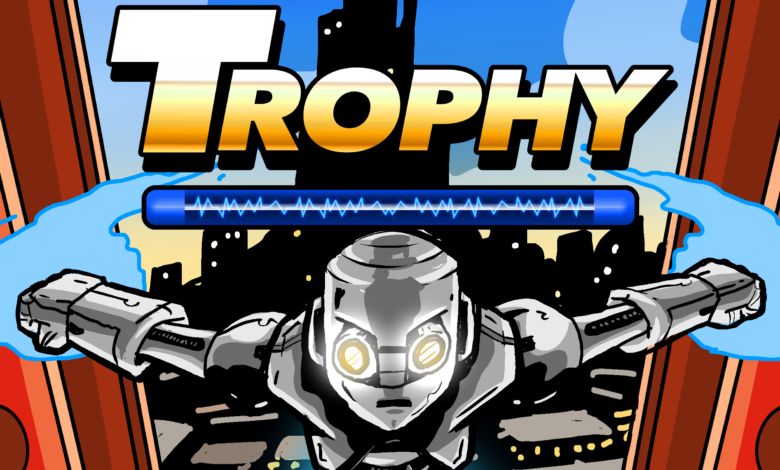
Review: Trophy [Switch]
The Original Nintendo Entertainment System was renowned for changing the video game playing field with its 8-bit graphics and games. We’ve reached a place where nostalgia has brought us full circle to game companies recreating these games in the style of the original NES. 8-Bit Legit, through one of their many successful Kickstarter campaigns in 2020, created a fun, 2D platformer called Trophy.
Originally released at a physical copy to be played on an NES or emulator, the game has found its way to the Nintendo Switch and XBox One consoles. But how does Trophy compare to the classic games of yesteryear?
A Prize-Winning Complex Backstory

The plot is incredibly in-depth for a simple platformer (as were several of the classic NES titles). Creator Derek Andrews apparently came up with the character and idea for Trophy when he was 12 years old. Two spacefaring computer scientists, Jared Sword and Xella Quine, discover a peaceful planet of robots named Gearus 9. After spending some time on the world, Sword returns to earth taking a little robot named Beeper as proof of the discovery.
However, back on Gearus 9, Quine finds himself isolated and goes mad, reprogramming the peaceful robots, and proclaiming himself Lord Q! When Sword and Beeper return, they must fuse into one being, part human and part machine. From the two, TROPHY is born!
Memories, Relics, and Melodies of Days Gone By
The game plays like Mega Man. Indeed, the entire scope of the game is based off the Blue Bomber’s adventures. You get to choose between any of the 8 initial available worlds to start (the 9th unlocking after you beat them all). You run forward. You can shoot forward and backward. You get a decent amount of hang-time on jumps. You get knocked back when hit by a bad guy. You fight really big bosses at the end of each level.
Trophy was programmed from the ground up in 6502 assembly language, by Andrews over the course of three years. He has been programming NES games for a decade, with Trophy being their third release. The other two were Nomolos: Storming the Castle in 2012 and 2016’s The Legends of Owlia.

Andrews also wrote the game’s music which is obviously inspired by Mega Man levels. But it doesn’t come off as a copy, instead the tones definitely add to gameplay. Players will even notice graphic glitches on the right side of the screen as they move forward. Not totally sure that’s intentional, but it certainly does add to the classic feel of an original NES game.
Overall, this entire thrust of Trophy seems to be maintaining the integrity of a classic, early platformer. The game lets you run jump, and shoot, unhampered by excessive power-ups or multiple abilities. The emphasis is truly on purity.
Chase the Retro Medal, or Leave it in the Past
To sum up, during the late 80s and early 90s there were a variety of platformers on the NES. The system excelled at them. Although, most have been forgotten, the standouts like Mega Man are remembered fondly. Trophy does its best to recapture the feel of this type of game while still maintaining a touch of uniqueness. While it doesn’t have much re-playability after you beat it, it’s still a fun journey getting there.

Trophy is available in the Nintendo eShop for Switch and on XBox One. Review generously provided by 8-bit Legit.
VERDICT
GOOD
GOOD
A Mega Man clone that utilizes the classic technology to not only be an homage to classic platformers, but to become a pure example of what was best about early NES action games. Enjoyable for retro and classic games

